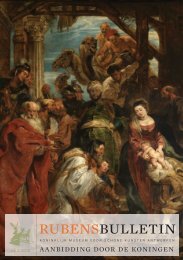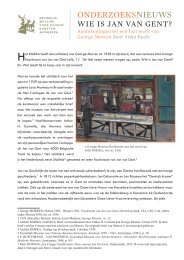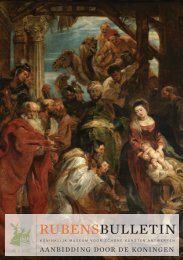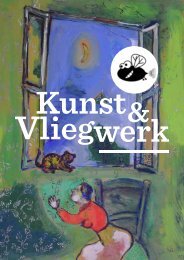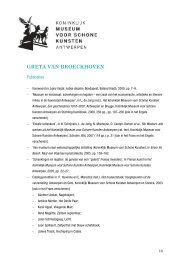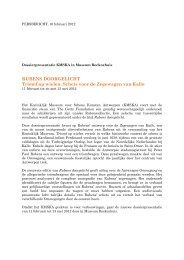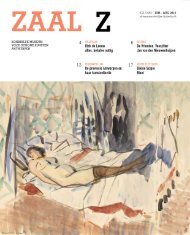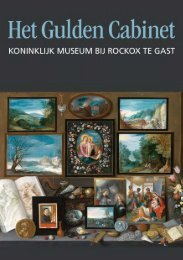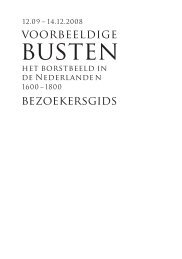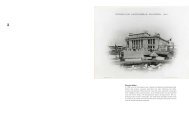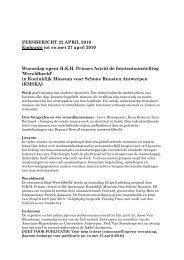III. Painting Technique and Restoration (PDF, 5,21 MB) - Koninklijk ...
III. Painting Technique and Restoration (PDF, 5,21 MB) - Koninklijk ...
III. Painting Technique and Restoration (PDF, 5,21 MB) - Koninklijk ...
You also want an ePaper? Increase the reach of your titles
YUMPU automatically turns print PDFs into web optimized ePapers that Google loves.
BULLETIN<br />
BULLETIN<br />
heifer’s head is painted with a high degree of finish<br />
(ill. 25) while her hind legs, in shadow, have a more<br />
summary, almost sketchy execution (ill. 26).<br />
This is a painting that can best be appreciated by st<strong>and</strong>ing<br />
at some distance. As we have seen Rubens employed<br />
a number of devices to enhance the element of space<br />
within this composition. The final brush strokes may<br />
well have been the rapidly applied highlights added<br />
to the fork in the foreground <strong>and</strong> some of the more<br />
hurriedly applied cobwebs in the rafters, again with the<br />
idea of drawing us into this remarkable painting.<br />
Susan Farnell<br />
Ill.25 The central heifer’s<br />
head is painted with a high<br />
degree of finish.<br />
Rubens is believed to have retouched The Prodigal Son later on in his life.<br />
The painting was, in any case, in his possession at the time of his death.<br />
Apparently the artist was unable to resist the temptation of making<br />
adjustments to the composition. Unlike the other faces in the painting,<br />
that of the stable h<strong>and</strong> on the far left is executed in very expressive, patchy<br />
brushstrokes. This style does not correspond with the smooth, calligraphic<br />
approach that is so characteristic of Rubens’s work from around 1618. The<br />
white horse also appears to have been retouched. Its head, unlike the rest of<br />
its body, was not kept in reserve, but sketched onto the brown background<br />
colour in a few quick light brushstrokes. The hind end <strong>and</strong> tail have been<br />
accentuated with some touches of white paint, so that the horse catches<br />
more light <strong>and</strong> thereby draws the viewer’s attention. Also, Rubens added<br />
some volume to the right flank of the brown horse. The purpose of these<br />
corrections was possibly to achieve a better balance in the composition.<br />
Without the alterations, clearly the most illuminated areas in the picture<br />
were on the right-h<strong>and</strong> side.<br />
In the print after the painting by Schelte Adamsz Bolswert, one notices<br />
that the large deciduous tree in the farmyard was originally a rather measly<br />
pollard willow. We were able to determine by means of an infrared image<br />
that Rubens reserved the shape of this pollard willow in the paint layer, as<br />
we notice the stripy imprimatura through the thinly applied paint of the<br />
trunk (ill. 7). This is however not the case for the rest of the trunk <strong>and</strong> the<br />
branches, which were painted over the greyish-blue sky. Perhaps Rubens<br />
chose to add a lush crown to soften the transition from the bright sky<br />
to the angular contours of the barn. Rubens is known to have retouched<br />
other paintings which he felt no longer tied in with his artistic aims. In<br />
quite a few cases, such corrections involved adjustments <strong>and</strong> sometimes<br />
enlargements of the support. 18<br />
There are hardly any other paintings of this size in Rubens’s oeuvre that have<br />
been painted as sketchily as The Prodigal Son. The explanation probably<br />
lies in the fact that the barn, which takes up most of the composition, is<br />
shrouded in twilight, <strong>and</strong> Rubens tended to provide far less detail in the<br />
darker areas of his paintings than in the brighter ones. The only comparable<br />
“cabinet picture” is The Calydonian Boar Hunt in Los Angeles (c. 1611), 19<br />
in which the boar as well as the foreground <strong>and</strong> background are also<br />
rendered rather sketchily. There are however a<br />
number altarpieces, including the Adoration of<br />
the Magi in Antwerp (1624), the St. Ildefonso<br />
Triptych in Vienna (1630-31) <strong>and</strong> the Adoration<br />
of the Magi in Cambridge (1633-34), which<br />
were executed with similar economy of means.<br />
The same holds for the monumental Hercules<br />
Drunk in Dresden (1613-14). 20 Rubens executed<br />
these large paintings himself, quickly, alla<br />
prima, with medium-rich paints that he could<br />
apply thinly to the panels. As a consequence,<br />
the chalk glue ground is visible through the<br />
paint layer in many places in these works. As<br />
in The Prodigal Son, individual brushstrokes<br />
in the abovementioned paintings are visible<br />
Ill. 7 The grey stripey imprimatura is visible under the<br />
transparent paint layer of the tree <strong>and</strong> the wooden post.




